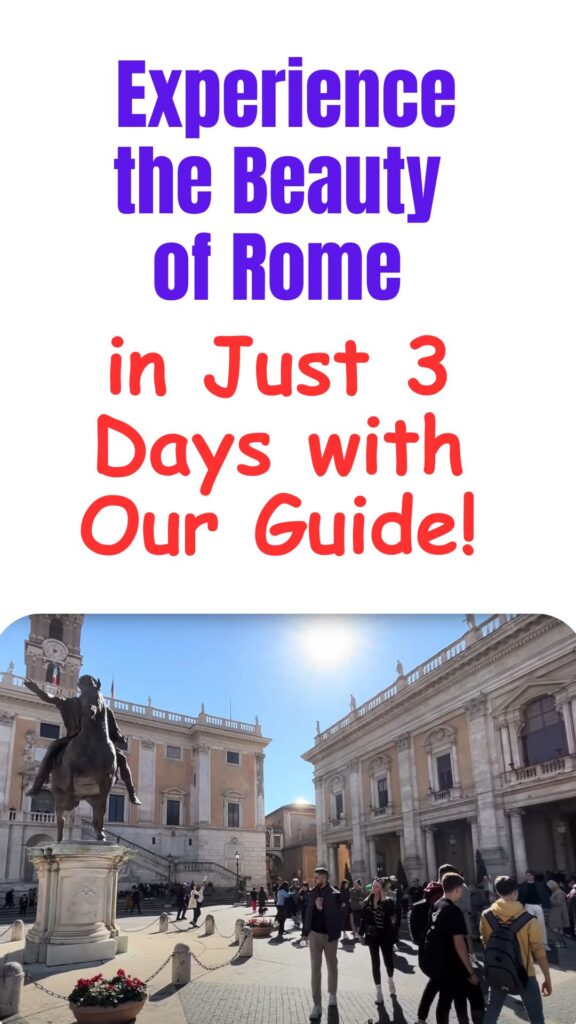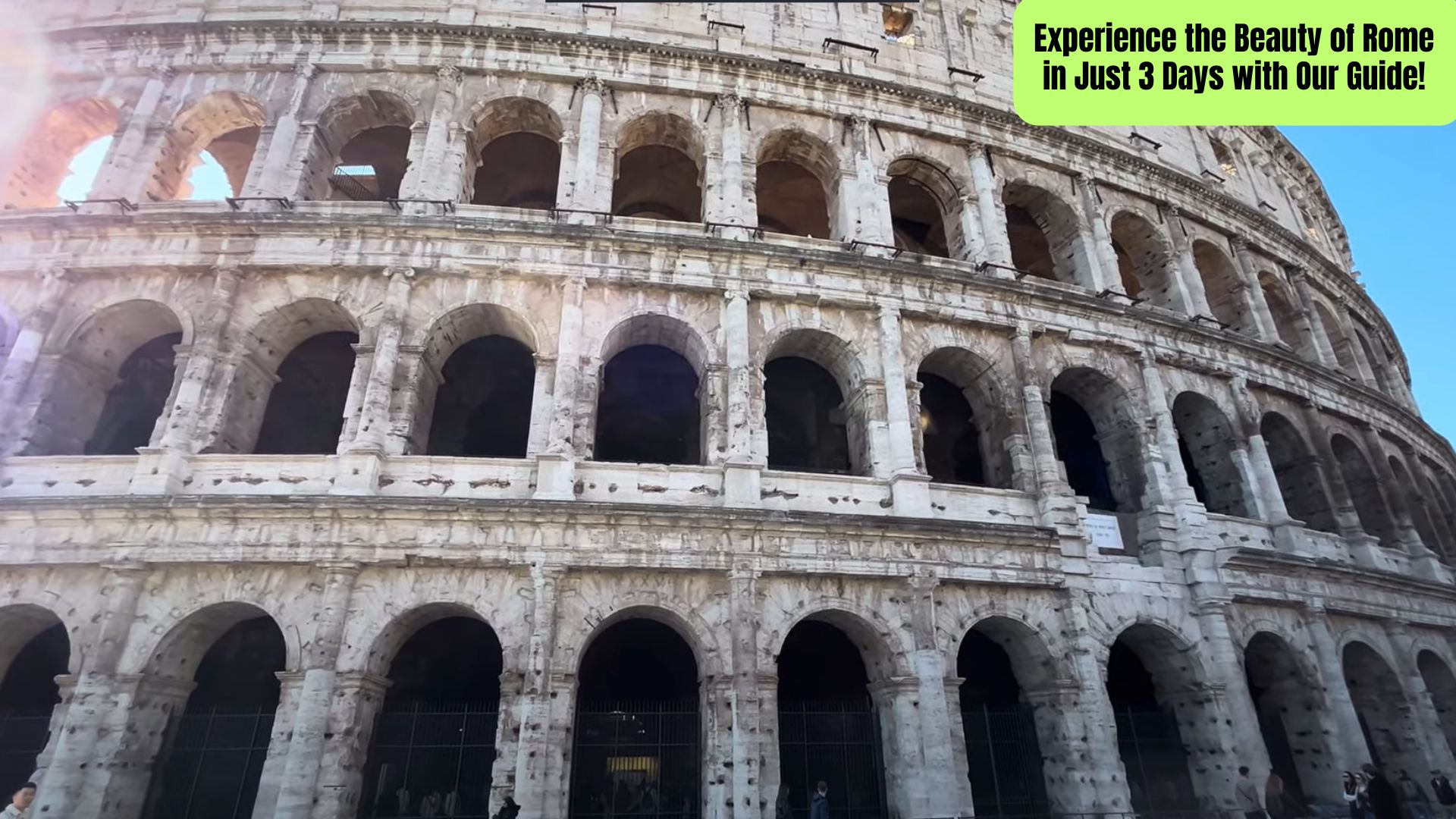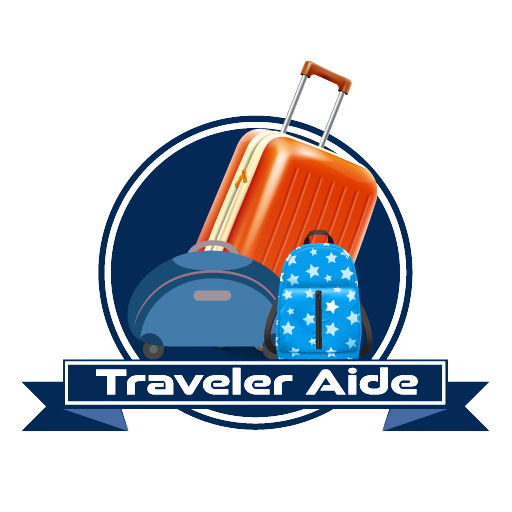Rome is one of those cities that overwhelms you—in the best way. Every corner feels like a scene from a movie. Ancient ruins, buzzing piazzas, warm bowls of pasta, and the scent of fresh espresso in the air—it’s all very Roman. But can you really experience Rome in just 3 days?
Surprisingly, yes. You won’t see everything, but you can absolutely soak up its timeless charm, hit the must-sees, and even find quiet pockets locals love. With smart planning, comfy shoes, and the right guide (that’s us), you’ll leave feeling like you’ve lived a little slice of La Dolce Vita.
Let’s dive into how to make the most of your Roman holiday.
Day 1: Dive into Ancient Rome & Central Highlights
Your first day is all about going back in time—literally. The Colosseum, Roman Forum, and Palatine Hill will transport you to the days of emperors, gladiators, and togas. Get ready to walk a lot today!
Morning: Start with the Colosseum (8:30 AM)
You’ll want to arrive early—lines can be long, and the sun gets hot fast. If you can, book a skip-the-line ticket or join a small group tour. That way, you’ll hear all the juicy stories: like how gladiators trained for years, or how trapdoors made animals appear mid-fight. It’s hard not to feel tiny standing inside this 2,000-year-old arena.
Tip: The underground and upper-tier areas require a guided tour. Totally worth it if you’re into Roman history.
Mid-Morning: Wander the Roman Forum & Palatine Hill
Just a short walk from the Colosseum, this open-air museum is where ancient Rome came alive. Picture busy marketplaces, grand temples, and political speeches being shouted across the square.

Palatine Hill gives you sweeping views over the Forum and Circus Maximus. Legend says it’s where Romulus founded Rome—so you’re literally standing on the birthplace of a civilization.
Take it slow here. There are lots of ruins, and it’s easy to rush. But sitting on a stone bench and imagining what life was like is part of the magic.
Lunch Break: Trattoria Luzzi (near Colosseum)
After all that exploring, head to Trattoria Luzzi. It’s casual, budget-friendly, and filled with locals. Their wood-fired pizzas and classic cacio e pepe hit the spot. Bonus: they serve lunch all afternoon, so no rush if you’re running late.
Afternoon: Stroll to Piazza Venezia & the Altare della Patria
From the Forum, make your way to Piazza Venezia. You can’t miss the massive white monument known as the Altare della Patria or “The Wedding Cake.” It’s a bit divisive among locals (some love it, others say it’s an eyesore), but you can’t argue with the rooftop views.
There’s a small elevator to the top. From there, you’ll spot St. Peter’s dome, the Colosseum, and rooftops stretching to the horizon.
Evening: Toss a Coin at the Trevi Fountain
End your first day with a little tradition. Head to the Trevi Fountain in the early evening—just after sunset is perfect. It glows beautifully under the lights, and while it’s always crowded, the energy is part of the experience.
Stand with your back to the fountain and toss a coin over your left shoulder. Legend says it guarantees your return to Rome. (We did it. And we did come back.)
Tip: Watch your bag here. It’s safe, but pickpockets love busy tourist spots.
Dinner: Osteria da Fortunata (Near Campo de’ Fiori)
This cozy spot serves handmade pasta rolled right in front of you. Their carbonara is creamy and just salty enough, and the gnocchi melts in your mouth. It’s popular, so go early or be ready to wait. But trust us—it’s worth it.
Day 2: Art, Faith & Local Vibes
Day two blends spiritual awe, artistic wonder, and chilled-out Roman charm. You’ll start in the world’s smallest country—Vatican City—and finish in one of Rome’s most authentic neighborhoods: Trastevere.
Morning: Vatican Museums, Sistine Chapel & St. Peter’s Basilica (8:00 AM)
Set your alarm early! Vatican City gets packed, and there’s a lot to see. Pre-book skip-the-line tickets or go with a guided tour for a smoother experience.
Start with the Vatican Museums. Even if you’re not an art buff, walking these halls feels surreal. Highlights include:
- The Gallery of Maps – detailed frescoes of Italy’s regions from the 16th century.
- Raphael Rooms – jaw-dropping Renaissance art.
- Sistine Chapel – and of course, Michelangelo’s famous ceiling. Yes, your neck will hurt from looking up. But wow—it’s worth it.
Note: Silence is expected inside the Sistine Chapel, and photos aren’t allowed.
Late Morning: St. Peter’s Basilica
From the Sistine Chapel, follow the signs to St. Peter’s Basilica. No matter how many photos you’ve seen, walking into this church feels breathtaking. The scale, the marble, the silence—it’s a moment.
Make sure to:
- Admire Michelangelo’s Pietà near the entrance.
- Climb the dome (Cupola) for stunning panoramic views over Rome. It’s 320+ steps, or take an elevator halfway and walk the rest. Either way, it’s a must-do.
Tip: Shoulders and knees must be covered. Bring a scarf or long-sleeved layer just in case.
Lunch: Pizzarium Bonci (Near Vatican Walls)
Ready for the best pizza-by-the-slice in Rome? Head to Pizzarium Bonci, just a 10-minute walk from the Vatican. Locals and foodies alike swear by it. Flavors change daily—think prosciutto with figs, or potato with rosemary. Grab a few slices and eat standing outside with the crowd.
Afternoon: Castel Sant’Angelo & Stroll Along the Tiber
Walk off lunch with a scenic stroll to Castel Sant’Angelo. Originally built as a mausoleum for Emperor Hadrian, it’s had many lives—fortress, prison, papal hideout. The view from the top is especially lovely at sunset, but even in the afternoon, you get a romantic panorama of bridges and domes.
Cross the Ponte Sant’Angelo, lined with Bernini-designed angel statues. It’s one of the most photogenic bridges in Rome.
Evening: Discover Trastevere
By now, you’re ready for a slower pace. Cross the Tiber into Trastevere, a lively yet laid-back neighborhood. Cobbled streets, ivy-covered facades, little piazzas—it feels like a movie set.
Take your time wandering. Stop for a gelato at Günther Gelato or enjoy a glass of local wine in Piazza Santa Maria while street musicians play in the background.
Dinner: Tonnarello or Da Enzo al 29
Two fantastic dinner spots here:
- Tonnarello – Famous for heaping bowls of pasta and friendly service. The outdoor tables are perfect for people-watching.
- Da Enzo al 29 – A tiny trattoria with a cult following. Their amatriciana and tiramisu are unforgettable.
Tip: Trastevere gets busy! Go early or book in advance if possible.
Day 3: Hidden Gems & Classic Roman Moments
Your last day in Rome should feel like a warm goodbye. You’ve seen the big sights—now it’s time to slow down and explore the city’s softer side. Think lesser-known treasures, beautiful piazzas, and the kind of streets you get lost in on purpose.
Morning: Explore Campo de’ Fiori & Piazza Navona
Start your morning with a walk through Campo de’ Fiori. If it’s a weekday, you’ll catch the market in full swing—fresh produce, handmade pasta, flowers, and Roman banter flying from stall to stall.
From there, it’s a short walk to Piazza Navona, one of Rome’s prettiest squares. You could easily spend an hour just sitting on a bench here. Watch the fountains, street artists, and flocks of pigeons doing their thing around Bernini’s famous Fountain of the Four Rivers.
Tip: Want a great espresso? Stop by Sant’Eustachio Il Caffè, just a 5-minute walk away. It’s a Roman institution.
Late Morning: The Pantheon & Largo di Torre Argentina
Next, head to the Pantheon. It’s free to enter (though there’s now a small fee on weekends), and once inside, the dome steals the show. No matter how many churches or temples you’ve seen, this one feels different—peaceful, eternal.
Not far from the Pantheon is Largo di Torre Argentina, a sunken square filled with ancient ruins and…cats. Yep, this is Rome’s famous cat sanctuary, home to dozens of rescued felines who lounge among broken columns like tiny emperors.
Lunch: Roscioli Salumeria con Cucina
Looking for a proper Roman send-off? Grab lunch at Roscioli, a gourmet deli-restaurant hybrid not far from Campo de’ Fiori. Their carbonara is legendary, and they also offer charcuterie platters, fresh mozzarella, and a deep wine list. It’s the perfect balance of tradition and indulgence.
Reservations are a good idea, especially on weekends.
Afternoon: Villa Borghese & Pincian Hill Viewpoint
After lunch, make your way to Villa Borghese. This huge park is Rome’s version of Central Park—a perfect spot for a relaxed stroll, or even a nap in the shade.
- You can rent a bike or pedal cart and ride around the gardens.
- Visit Galleria Borghese (ticket required in advance) to see Bernini sculptures and Caravaggio paintings.
- Or simply walk up to the Pincian Terrace (Terrazza del Pincio), where you’ll catch one of the best views over Piazza del Popolo and the Roman skyline.
Tip: Bring a bottle of water and your camera—the golden light here in the afternoon is gorgeous.
Evening: Farewell Aperitivo at a Rooftop Bar
Wrap up your Roman adventure with a final toast. Rome has plenty of rooftop bars, but two favorites are:
- Terrazza Borromini – Overlooks Piazza Navona and offers a dreamy sunset setting.
- Les Étoiles – Near the Vatican, with sweeping views of St. Peter’s dome.
Order an aperol spritz or negroni, snack on olives and chips, and take a quiet moment to reflect. You’ve covered a lot in three days—and Rome has left its mark.
Travel Tips to Make Your 3 Days in Rome Easier
Rome is magical, but let’s be honest—it can also be overwhelming. Between the crowds, cobblestones, and constant temptations to eat one more gelato, you’ll want to be smart about how you navigate the city.
Here are some practical tips to make your trip smoother:
1. Book Major Attractions in Advance
If you’re planning to visit the Colosseum, Vatican Museums, or Borghese Gallery, buy your tickets ahead of time. Lines can stretch for hours, especially in summer. Skip-the-line or timed-entry tickets can save your sanity.
For popular restaurants like Da Enzo or Roscioli, reservations are recommended too—either through their websites or apps like TheFork.
2. Don’t Overpack Your Schedule
It’s tempting to see everything, but Rome isn’t a checklist. Wandering aimlessly through charming alleys and stumbling onto a tiny church or fountain is part of the joy. Leave space for surprises—and for sitting in a piazza doing absolutely nothing.
Tip: Limit yourself to 2–3 major sights per day. Fill in the rest with cafes, strolls, and breaks.
3. Stay Central if Possible
To make the most of your time, stay somewhere central—ideally in Centro Storico, Trastevere, or Monti. That way, you’re close to most of the main attractions, and you won’t waste time commuting across the city.
If you’re on a budget, the Termini Station area is cheaper and well-connected, but it can be noisier and less charming.
4. Comfortable Shoes Are a Must
Rome’s beauty lies in its streets—but those streets are mostly uneven cobblestones. You’ll easily walk 15,000+ steps a day, so good walking shoes are non-negotiable.
Skip the brand-new sandals or flimsy flats. Trust us—your feet will thank you.
5. Learn a Few Italian Phrases
Romans are used to tourists, but speaking a few words of Italian goes a long way. Even just “Buongiorno” (good morning), “Grazie” (thank you), and “Per favore” (please) can make your interactions warmer and friendlier.
How to Get Around Rome Efficiently
You can use public transport in Rome—but in many cases, walking is faster and more pleasant. That said, here’s a quick breakdown of your options:
- Metro: Only three lines (A, B, and C). Line A takes you to the Vatican and Spanish Steps. Line B goes to the Colosseum and Termini. It’s efficient, but limited in coverage.
- Bus/Tram: Rome’s bus system is vast but not always reliable. Use Google Maps or the Moovit app for routes. Validate your ticket when boarding.
- Taxis & Rideshares: White taxis are official and metered. Uber exists, but is often more expensive than local cabs. For short distances, walking is usually better.
- Airport Transfers: From Fiumicino (FCO), take the Leonardo Express train (32 minutes to Termini). From Ciampino, use buses or pre-book a shuttle.
When’s the Best Time to Visit Rome?
Rome is beautiful year-round, but each season has its pros and cons:
- Spring (March–May): Perfect weather. Flowers blooming, outdoor dining in full swing, and moderate crowds. It’s one of the best times to visit.
- Summer (June–August): Hot and packed. If this is your only option, go early in the day and stay hydrated. Many locals leave in August, so some places may be closed.
- Fall (September–October): Still warm, fewer tourists. October sunsets in Rome are especially golden. Great time for food lovers, as truffle and wine season kicks in.
- Winter (November–February): Quieter and cheaper, especially after the New Year. Some rain, but Christmas lights and empty museums make it magical in a different way.
Final Thoughts: Rome in 3 Days is Totally Doable
Rome doesn’t need a month to work its charm. In just three days, you can stand in the shadows of the Colosseum, gaze up at the Sistine Chapel, sip wine in a sunlit piazza, and walk the same streets that Julius Caesar once did.
Will you see every single church, ruin, and museum? No. But will you feel Rome—its energy, its flavors, its history? Absolutely.
The secret is balance. Don’t rush. Soak it in. And remember: Rome will always welcome you back for another scoop of gelato.
Quick Itinerary Recap: 3 Days in Rome
Here’s a condensed version of our suggested itinerary:
Day 1 – Ancient Rome & City Essentials
- Morning: Colosseum, Roman Forum, Palatine Hill
- Lunch: Trattoria Luzzi
- Afternoon: Piazza Venezia & Altare della Patria
- Evening: Trevi Fountain + Dinner at Osteria da Fortunata
Day 2 – Vatican & Trastevere
- Morning: Vatican Museums, Sistine Chapel, St. Peter’s Basilica
- Lunch: Pizzarium Bonci
- Afternoon: Castel Sant’Angelo & Tiber River stroll
- Evening: Trastevere exploration + Dinner at Tonnarello or Da Enzo
Day 3 – Hidden Gems & Farewell Views
- Morning: Campo de’ Fiori, Piazza Navona, Pantheon
- Lunch: Roscioli
- Afternoon: Villa Borghese & Pincian Terrace
- Evening: Rooftop aperitivo (Terrazza Borromini or Les Étoiles)
Rome FAQs: What Travelers Always Ask
Q: Is Rome safe for solo travelers?
A: Yes! Rome is generally safe. Pickpocketing can happen, especially at tourist hotspots, so keep an eye on your bag. Walking around at night in well-lit areas is fine, especially in the center.
Q: How much cash should I carry?
A: Most places take cards, but it’s good to have €20–50 in cash for small purchases, local markets, or cafes that have a card minimum.
Q: Can I drink the tap water in Rome?
A: Yes! Rome’s tap water is safe, clean, and comes from mountain springs. Refill your bottle at nasoni (public fountains) around the city. They’re everywhere.
Q: What should I wear to churches?
A: Cover shoulders and knees. Bring a scarf or light cardigan in your day bag. It’s especially important at the Vatican and more traditional churches.
Q: What’s a good souvenir to take home?
A: Skip the magnets and grab:
- Dried pasta or truffle products from a local market
- Hand-painted ceramics
- A bottle of Italian wine or limoncello
- Leather goods from Campo Marzio shops
Q: How do I avoid long lines at major attractions?
A: Always pre-book skip-the-line tickets or go with a guided tour. Early mornings and late afternoons tend to be quieter at the big sights.
Your Roman Holiday Starts Here
Three days in Rome won’t just fill your camera roll—it’ll leave you with a head full of history, a heart full of pasta, and feet that might need a break.
But that’s Rome. She’s ancient and chaotic, loud and beautiful, and somehow always exactly what you didn’t know you needed.
Ready to experience the beauty of Rome in just 3 days? Pack your curiosity, your appetite, and a pair of good shoes—and let the Eternal City do the rest.


